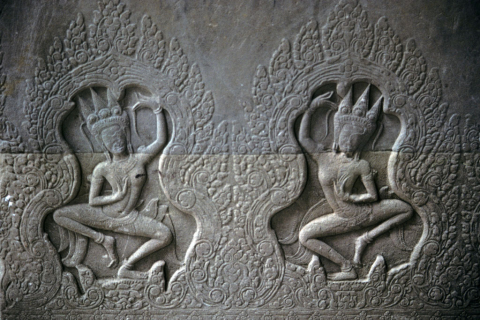
852094800
Two dancing female deities with spiked crowns are carved in low relief and surrounded by carved floral designs. The figures in mirror image stances balance on one bent leg in active positions typical of classical Southeast Asian dances. One hand is held above the head and the other in front of the chest with their wrists and fingers stretched backwards towards the sky.
These dancing female divinities (each called an "apsaras") are said to be created for the entertainment of the Hindu gods. They often are recognizable from their filmy skirts and spiked crowns, although the number of spikes in the crowns may vary. Angkor Wat is known for hundreds of images of these divine nymphs, who usually are posed alone, but sometimes are clustered in groups.
The dancing nymphs' feet always are positioned sideways with toes bent backwards, and their hair usually hangs in a few braids below their crowns. They wear wrapped skirts and jewelry, but no top garments, which was customary for both women and men in many areas of tropical Southeast Asia prior to European contact.
According to Hindu scriptures, these dancing divinities, whose name means "moving in water" in Sanskrit, were the first beings to emerge from the Churning of the Sea of Milk in the Hindu myth of creation.
Creative Commons BY-NC-SA
 852094800
852094800